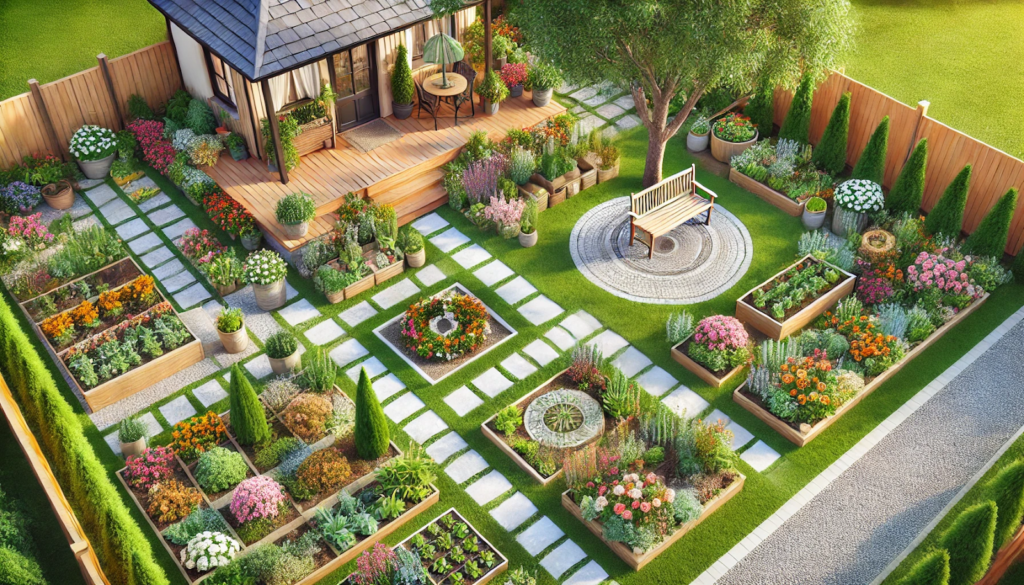A well-designed home garden is more than just a collection of plants—it’s a personal sanctuary, a productive space, and a place of beauty. Whether you’re working with a large backyard or a small patio, smart garden design can help you make the most of your space, reflect your personality, and support your lifestyle.
In this guide, you’ll learn how to design a home garden that’s not only beautiful but also functional, low-maintenance, and full of year-round interest.
1. Start with a Garden Plan
Great gardens begin with a plan. Before you plant a single flower, take time to evaluate your space.
Key Questions to Ask:
- How much sunlight does each area receive?
- What is the quality and drainage of the soil?
- How do you plan to use the space (relaxation, growing food, entertaining)?
- Do you prefer a formal or informal design style?
Sketch a simple layout or use an online garden planning tool. Mark out walkways, beds, focal points, and seating areas.
2. Choose a Focal Point
A focal point draws the eye and adds structure to your garden design.
Ideas for Garden Focal Points:
- A tree with striking form or color
- A water feature like a fountain or pond
- A garden bench or pergola
- A sculpture or birdbath
- A flower bed with bold color contrast
Center the design around this element and build out symmetrically or organically from there.
3. Mix Height, Color, and Texture
A beautiful garden balances variety with harmony. Use layers to create depth and visual interest.
Design Layers:
- Tall plants in the back (trees, ornamental grasses, sunflowers)
- Medium-height plants in the middle (roses, coneflowers, shrubs)
- Low-growing plants in the front (ground covers, herbs, succulents)
Combine plants with different leaf textures, shapes, and bloom times for a dynamic and evolving garden through all seasons.
4. Define Pathways and Structure
Clear paths not only guide movement but also make a garden feel intentional and organized.
Pathway Ideas:
- Stone or gravel walkways
- Mulch or wood chip trails
- Stepping stones between beds
- Brick or tile for formal gardens
Border paths with low-growing plants or edging for a polished look.
5. Combine Beauty with Function
You can have both a stunning and productive garden. Integrate edibles and ornamentals in the same space.
Examples:
- Grow lavender and marigolds around vegetable beds for color and pest control
- Plant tomatoes and peppers in decorative pots near a patio
- Add a vertical herb wall on a sunny fence
Mixing flowers and edibles enhances biodiversity and keeps the garden engaging.
6. Choose Low-Maintenance Plants
Design a garden that fits your schedule. Select plants that match your climate and soil conditions.
Best Low-Maintenance Plant Types:
- Native plants and wildflowers
- Drought-tolerant species like sedum, salvia, or yarrow
- Perennials that return each year
- Mulch-heavy beds to reduce weeding and watering
Avoid fussy plants that require constant pruning, pest control, or special soil.
7. Add a Seating Area
A garden should be a place to enjoy, not just work. Designate a spot where you can relax and take in the view.
Seating Ideas:
- A wooden bench under a tree
- A bistro table with chairs for morning coffee
- Hammocks or garden swings
- A pergola with vines for summer shade
Surround your seating area with fragrant flowers or herbs like lavender, thyme, or rosemary for a calming atmosphere.
8. Use Raised Beds or Containers
For small spaces or poor soil, raised beds and containers offer beauty and flexibility.
Benefits:
- Easier access for planting and maintenance
- Better soil drainage and control
- Defined borders create visual structure
- Can be moved or changed with the seasons
Paint or stain raised beds to match your garden aesthetic.
9. Plan for All Seasons
Design your garden to offer beauty even when flowers aren’t blooming.
Tips:
- Include evergreen shrubs for winter interest
- Use ornamental grasses for movement and color in fall and winter
- Plant bulbs in fall for early spring blooms
- Choose trees with colorful bark or branches
A year-round garden maintains visual appeal in every season.
10. Incorporate Lighting and Decorative Elements
Extend your garden’s enjoyment into the evening with soft lighting and artistic touches.
Ideas:
- Solar lights along pathways
- String lights or lanterns near seating areas
- Decorative trellises or arbors
- Painted pots, birdhouses, or wind chimes
These elements add personality and make your garden feel welcoming at all hours.
Bonus: Attract Pollinators and Wildlife
A beautiful garden is also one that supports local ecosystems.
How to Do It:
- Plant nectar-rich flowers for bees and butterflies
- Use native plants that support local insects and birds
- Include a birdbath or small water feature
- Avoid pesticides and chemical fertilizers
Pollinators make your garden more vibrant and productive.
Conclusion: Design with Purpose and Joy
Creating a beautiful home garden doesn’t require a massive space or a professional landscaper. With thoughtful planning, attention to detail, and a mix of form and function, you can design a space that brings you joy, enhances your home, and supports the environment.
Your garden is an extension of your living space—make it a place that reflects who you are and what you love.






